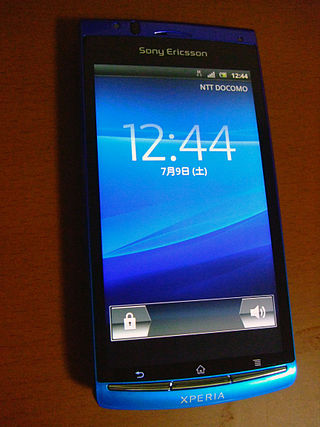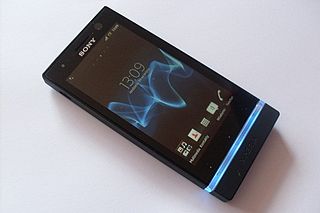Sony Mobile Communications Inc. was a multinational telecommunications company founded on October 1, 2001, as a joint venture between Sony Corporation and Ericsson. It was originally incorporated as Sony Ericsson Mobile Communications, and headquartered in London, England, until Sony acquired Ericsson's share in the venture on February 16, 2012. On April 1, 2021, Sony integrated its electronics businesses including Sony Mobile into one company called Sony Corporation.

Xperia is a series of and the sole brand name of smartphones marketed by Sony. It also includes various related mobile hardware such as tablets as well as software. Xperia was originally developed by Sony Ericsson before becoming Sony Mobile as a result of the mobile phone manufacturer being taken over and solely owned by Sony in 2012; it has been under Sony Corporation since 2021 following Sony Mobile's merger. The name Xperia is derived from the word "experience", and was first used in the Xperia X1 tagline of "I Xperia the best".

The Xperia Play is a smartphone with elements of a handheld game console produced by Sony Ericsson. With the marketshare for dedicated handheld game consoles diminishing into the 2010s due to the rapid expansion of smartphones with cheap downloadable games, Sony attempted to tackle the issue with two separate devices; a dedicated video game console with elements of a smartphone, called the PlayStation Vita, and a smartphone with elements of a handheld console, the Xperia Play. Originally rumored to be a "PlayStation Phone", the device shed the "PlayStation" branding in favor of the Xperia brand, running on the Android operating system.

The Sony Ericsson Xperia arc is an Android smartphone launched on March 24, 2011 in Japan, and April 1, 2011 in Europe.

The Sony Ericsson Xperia pro is an Android smartphone from Sony Ericsson which was launched in October 2011. The Xperia Pro has a 3.7-inch (94 mm) capacitive touch-screen, slider keyboard, smart phone with mobile BRAVIA engine which optimises the picture and runs at a resolution of 854×480 pixels, a 1 GHz Snapdragon processor, an 8.1 mega-pixel camera, a dedicated Two-step camera key, USB host port, HDMI-out, 512 MB of onboard RAM, and an 8 GB microSD card. The Sony Ericsson Xperia Pro is available in black, silver, or red.

Sony Ericsson Xperia Neo is an Android smartphone by Sony Ericsson, superseding the Sony Ericsson Vivaz, released in 2010 and preceding the Sony Xperia P, released in 2012. It was launched in early 2011. During its development it was codenamed Hallon.

The Sony Ericsson Xperia acro is an Android-based smartphone produced by Sony Ericsson Mobile Communications in Japan. The device has several additional functions for Japan customers from Xperia Arc. It was launched on 24 June 2011.

The Sony Ericsson Xperia arc S is a high-end smartphone developed by Sony Ericsson running Google's operating system Android 2.3.4 (Gingerbread). It is an upgraded version of the Sony Xperia Arc. It is the last phone announced to carry the Sony Ericsson brand, although Sony Ericsson Xperia active was the last phone completed before Sony bought Ericsson's stake in the joint-venture.

The Sony Ericsson Xperia ray (ST18i) is an Android smartphone from Sony Ericsson. It was unveiled on 22 June 2011 in Singapore during CommunicAsia 2011. It was announced that the Xperia ray would be released globally in select countries from Q3 2011.

The Sony Xperia S is an Android smartphone from Sony launched at the 2012 Consumer Electronics Show. It was first released in February 2012 as the Sony Ericsson Xperia NX in Japan, while the Sony Xperia S was released in March 2012 as a restyled version of the Sony Ericsson Xperia NX in more than 160 countries. It is the first Sony-only branded smartphone after Sony acquired Ericsson's stake in Sony Ericsson in January 2012. The Xperia S has a 4.3 in (110 mm) touch-screen with the mobile BRAVIA engine which optimizes the picture, a 1.5 GHz dual core processor, a 12.0-megapixel rear camera, HDMI-out, 1 GB of RAM, and 32 GB of internal storage.

The Sony Xperia U ST25i, codenamed Kumquat during its development, is an Android smartphone from Sony. It was launched at the 2012 Mobile World Congress held in Barcelona, and is the second Sony-only branded smartphone after Sony acquired Ericsson's stake in Sony Ericsson in January 2012. The Xperia U has a 3.5-inch (88.9 mm) touch-screen with the mobile BRAVIA engine which optimises the picture, a 1 GHz dual core processor, a 5 mega-pixel rear camera, 0.3 mega-pixel front camera, 512 MB of RAM, and 8 GB of internal storage. The cap at the bottom of the phone is interchangeable. The phone is shipped with four caps: pink, white, yellow and black.
The Sony Xperia V is a smartphone designed, developed and marketed by Sony Mobile. Presented initially on 29 August 2012 in Berlin, the Xperia V was released in December 2012 and belongs to Sony's handset line up of the second half of 2012, which includes the flagship Xperia T and the entry-level Xperia J. The 4.3-inch (110 mm) device employs a 1280×720 (720p) pixel resolution display, a 1.5 GHz dual-core processor and a 13-megapixel camera, and an interchangeable battery while protected by a water-resistant outer skin. This is the first Sony Mobile's device alongside the Xperia J that does not feature the Sony Ericsson's liquid energy logo.
The Sony Xperia J is an Android smartphone from Sony. It was launched at the IFA 2012 in Berlin. It is also known as Sony ST26i.
Sony Xperia TX is an Android high-end smartphone from Sony Mobile Communications introduced on 29 August 2012, the Xperia TX is a version of the Sony Xperia GX SO-04D which was launched in May 2012, in Japan. It is Sony's first smartphone built on Qualcomm's Snapdragon S4 (MSM8260A) platform. The Xperia TX was officially released in October 2012 in three colors: Black, White and Pink.

The Sony Xperia Z is an Android-based smartphone by Sony. Announced at CES 2013 the phone was officially released on 9 February 2013 in Japan and 1 March 2013 in Singapore and the UK. It was released in the U.S months later. The Xperia Z was initially shipped with the Android 4.1.2 operating system. The smartphone has Ingress Protection Ratings of IP55 and IP57. It also contains a 13.1 MP Exmor RS camera sensor, and the screen of the phone consists of a TFT 1920x1080 display, with 441 ppi. It would be the first smartphone in the Sony Xperia Z series, continuing all the way up to the Xperia Z5.

The Sony Xperia neo L is a mid-range Android smartphone designed, developed and manufactured by Sony Mobile Communications. The Xperia neo L as first announced in March 2012 and was released in June 2012. The Xperia neo L was first made available in China and was later on released globally.
The HTC Desire 601 is an Android smartphone designed and manufactured by HTC. The Desire 601 is a mid-range device carrying design traits from the HTC One and One Mini, utilizing a dual-core processor, 4.5-inch qHD display, and offering LTE support.

The Sony Xperia Z3 is an Android smartphone produced by Sony. Part of the Sony Xperia Z series, the Xperia Z3, at that point known by the project code name "Leo", was unveiled during a press conference at IFA 2014 on September 4, 2014. It was first released in Taiwan on September 19, 2014.

The Sony Xperia Z5 Premium is an Android smartphone produced by Sony. Part of the Sony Xperia Z series, the device, at that point known by the project code name "Satsuki", was unveiled along with the Sony Xperia Z5 and Xperia Z5 Compact during a press conference at IFA 2015 on September 2, 2015. The device was first released in Taiwan on November 5, 2015, and was the first smartphone with 4K resolution.

The Sony Xperia T3 is an Android smartphone developed by Sony Mobile Communications. It was announced in June 2014 and was released in July 2014.















